
The landscape en route to Tongli is dotted with canals and ponds. It is very reminiscent of Holland, even down to the architecture of some houses. They are much larger than in other parts of China we have been to, reflecting the wealth of the region south of the Yangtze Rive thanks to the river, canals and its proximity to Shanghai and the world beyond. The only giveaway that we are in China is the tiles on the apex of the roofs. Almost every house has a different design with curved roof tiles stacked up into different shapes, often resembling the craft which ply the local waterways.
After driving through industrial estates the bus stops at a large gate just off a bustling road lined with shops. This doesn’t seem like the pretty little canal town I had been expecting. The old town centre is beyond the gate and most motorised traffic is prohibited from driving past the gate. We walk into the town past the main square to one of the canals where a number of wooden boats with blue covers are tied up by a bridge. All Jiangsu's canal towns encapsulate xiaoqiao, liushui, and renjia, which means bridges, water and people. Many poems have been written about China's water town scenery, and the scene in Tongli is just like a painting, the canals lined by houses going back hundreds of years to the Qing and Ming dynasties.
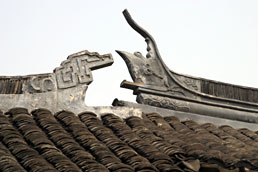


At a wide intersection where two canals meet there are three arched stone bridges, called Peaceful, Safe and Sound, and Lucky. Supposedly walking across all three brings you good luck, peace and safety. Obvious really. Some people come long distances to cross the bridges, especially married couples. Two small fishing boats moored by the have a number of cormorants perched on them. Their owner is preparing his bed under a canopy on one boat. The canal water does not look as though it would support any fish for the cormorants to catch.
Dinner on our first night is with the leader of the Tongli tourism development company. Conversation turns to my earlier feat of picking up four peanuts at the same time with chopsticks. The feat is matched on camera by Jiangsu Tourism Bureau's Chen Zhenghuai, who has been accompanying us around the province. We call it a draw – England 4, China 4. Honour is maintained all round. Later I am filmed checking into the hotel, setting up my laptop and making a cup of tea. Except that I accidentally drop the tea caddy lid into the cup. They decide to keep it as an outtake.
We get up early next morning to film around the town at dawn. The shops are not yet open but there are many people around, walking and cycling through the town and along the paths next to the canals. Others are sweeping the streets or washing clothes and cooking utensils in the canal water. One man empties the contents of his potty into the canal, on the same steps as a neighbour who is washing dishes and pots. It hardly seems hygienic. We walk to the three bridges and the cormorant fisherman is on his boat, pushing back the canopies and rolling up his bedding.

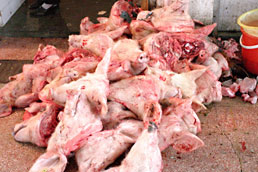
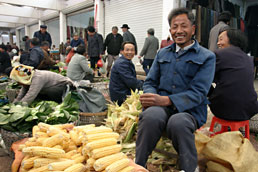
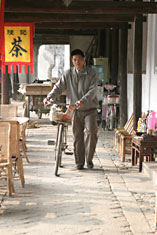
We go to the market and follow Mr Song Yiting, who runs the Yiting Guest House with his wife. I spot a pile of severed pigs’ heads on the market floor. It looks and smells disgusting, but gets scant attention from the market-goers. Pig’s heads are a delicacy as I know, having been served pig’s brain and face. A little further along is a stall selling the rest of the pigs’ bodies, and the tradesman is doing a roaring trade. In other areas of the market I photograph stallholders selling vegetables, spices, chickens, ducks and fish. They are all happy to let me take their pictures. Mr Song has bought a duck and some local produce, and we follow him as he wheels his bicycle back home, the duck in the shopping basket in front of the handlebars.
We sit at tables shaded by the canopy alongside the canal as the first of the day's tourist pleasure boats are rowed past. The occupants wave as they see us filming and photographing them. Mr Song tells me the house is 280 years old. He has been running the guesthouse for three years and it has five rooms. Before that he worked for an electrical engineering firm. He says life has changed since he started taking in guests because it has brought in more income to the family. Life has improved for his family and also for their neighbours, some of whom have done the same thing. He and his family have made many friends from China and abroad when they have stayed as guests. I ask is he is worried about the impact of more visitors on Tongli's culture and life, but he says no because Tongli's development is controlled to keep the original flavour of the place. For traditional canalside homes like his no outside alterations are allowed. I also ask about pollution in the waterways, having seen the people washing food, utensils and clothes in the canal water. Doubtless the sewers also empty into the canals, but he is not worried and says tourists now pay a lot of attention to the environment and won’t be a burden on it. He misunderstood me. It is the increasing strain put on Tongli’s old sewerage system by all the extra visitors which I believe is a major concern.
Tongli is fed by a river which has been turned into 15 canals and is surrounded by five lakes. It was only accessible by boat until 1985, when the first road was built to it. The canals are an integral part of life as well as being the reason tourists come. We take a boat trip on canal and I talk to the boat lady. She tells me there are 40 boats which take tourists on trips along the canals. They are traditional modes of transport in Tongli and for the local people were the only means of getting around prior to 1985. Now they are just for tourists. She tells me she worked for a chemical factory before working the boats, but it and other factories were closed down or moved out of Tongli to protect the environment.
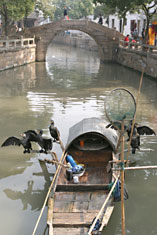
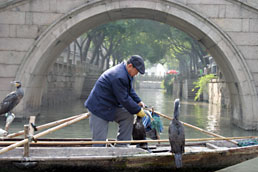
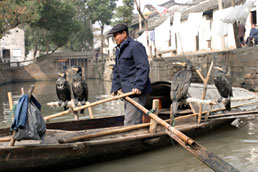
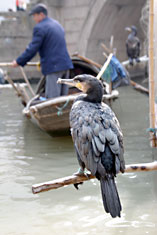
We end up at the three bridges junction, just in time to watch a demonstration by the cormorant fisherman. He uses a long bamboo pole to dislodge the birds from their perches into the water, whereupon they dive into the brown murk. Within seconds they reappear on the surface juggling fairly sizeable fish in their beaks. But their gullets are tied with string so they cannot swallow the fish. The fisherman uses the pole retrieve each one, grabbing the bird’s neck and easing the fish back out of its mouth into the boat before slinging it back. A sign on the wall says the birds are ospreys, but these are definitely cormorants. After the show I sit with the fisherman, Mr Ge, and Mr Yao, who runs the cormorant tourist show and acts rather more like a minder, fencing some of the awkward questions. Mr Ge says he has been a fisherman all his life, and before that his father and his father’s father. He still is a fisherman and depends on it for his living, supplementing his income with the show for tourists. He sleeps on his boat for much of the time but actually lives in a village nearby and usually fishes in one of the surrounding lakes. It takes anything from a year to six or even seven to train a cormorant. Obviously some are more bird-brained than others. They regard him as their father so they don’t fly away. Because the work is so hard, fewer people rely just on fishing as a living. Fewer are also learning how to catch fish with cormorants. I ask if the canal fish are edible and whether he eats what the cormorants catch, but he doesn't answer my question. Cormorant fishing is at least 1,000 years old, Mr Ge tells me, but it can only been seen in southern China. He is worried that no young people want to learn. He has two sons and three daughters and none of them wants to learn how to do it. He says it is a pity he hasn’t passed it on to his children and he concedes that it might die out as a traditional way of life, but as a father he does not want his children to work as hard as he does and endure the living conditions he has to. He wants them to have a better life. As a father myself I can understand that.
Before lunch we go to the Chen family residence, a series of very ornate buildings with their own private opera stage and private canal dating back to the Ming period. The roof decorations include lovely examples of the slate representations of boats and fantastic carvings of sea monsters, mythical creatures and gods. The main residence buildings have richly-carved wooden panels and screens and there are many of the different-shaped doorways popular in Jiangsu. I remark that the occupants must have been bloody rich. Filthy, stinking rich is probably a better description. With the canal right by their residence it might have been just that as well.
At lunch in a little restaurant next to one of the canals I talk to Mr Pinhua Yan, secretary of the Tongli Commission of the Wujiang Committee of the Chinese Communist Party. He tells me professors from a top Shanghai university were invited to draw up a plan for the preservation of Tongli. During the early 1980s many buildings were constructed which didn’t match the overall style of the old town, so they are being pulled down and businesses are being moved to the new town area. The town planners also want to make sure the old town does not become too commercial or touristy. They have established a street which caters specifically for tourists, and shops around tourist areas like the three bridges will be shut down. After lunch we go to Tuisi Garden, which has lovely mosaic pavements, courtyards and pavilions around a lake. I talk to Mr Yan there again, on camera. He says Tongli now gets two million visitors a year. They are studying how many it can take in the future, but he adds that facilities need to be improved so that it can take more visitors. There are also plans for more litter bins and water purification equipment to ensure water going into the canals is clean.

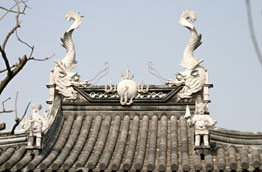
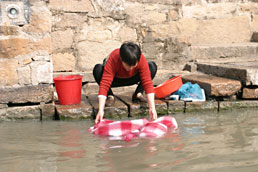
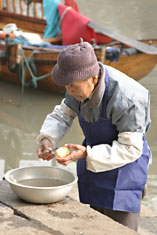
We leave Tongli and head to Nanjing. This lovely little town has captivated me even though we have only been there a couple of days. Little do I realise we would be back within a few days. The journeys to and from Nanjing will long live in my memory. Chinese motorways are like high-speed dodgems, the horn used incessantly, not so much to warn other drivers to move over but to let them know you are coming through. Our driver manages to squeeze the bus into impossibly tight gaps and, like many of the other road users, uses the hard shoulder as another lane – almost scraping the central reservation wall or traffic alongside. We make it back safely, somehow.
We take a short boat trip across Tongli Lake, one of the five surrounding the town, to Luoxing Island and visit Guanyin Temple. It is actually three temples – one Buddhist, one Taoist and one Confucian. They need a lick of paint as the yellow exterior wall, black roofs and red wooden temple structures are all peeling, but the complex has a lovely serene feeling. I imagine the temptation to down paintbrushes and meditate instead would be hard to resist. The original temple complex was built in the late Yuan dynasty and finished in the Ming dynasty, but in 1938 when the Japanese invaded Tongli the buildings were burnt down. The current temples were built in 1998, and had apparently not been redecorated since.
Back in the old town we walk through the narrow, shop-lined pedestrianised streets to the Nanyuan Tea House, or Southern Tea House, alongside a major canal junction. The sun is setting over the canal-side buildings opposite where a wooden fishing boat is unloading its catch and several canal boats chug past us. They all have sloping bows and sterns, presumably similar to craft which must have sailed these same waters for centuries. A small boat is being guided along by a young woman on the bow with a long pole. It is overtaken by a much larger barge, an older woman with a scarf over her head standing on the bow guard with an even longer pole while her husband steers the long-handled rudder from under a canopy at the stern. Another small, open, boat with graceful curves turns and heads away from us onto the other branch of the canal. It is being piloted by an old man standing at the back with his wife, dressed in a simple blue tunic and headscarf, huddled in a well near the front. As they turn the corner and disappear into the distance I wonder how many young people will follow their traditional way of life on the canals in the future.
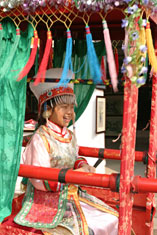
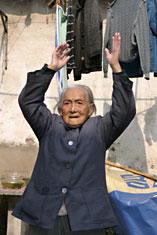
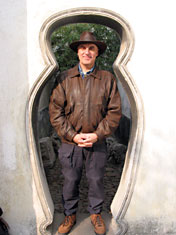
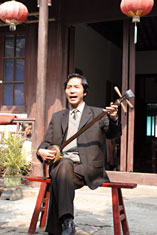
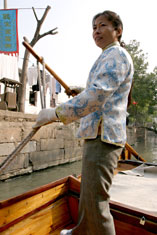
The tea house was first opened in the late Qing dynasty, over 100 years ago, by a fisherman and his wife and the style of its interior has remained much the same. We go upstairs, where some bamboo bird cages are hanging. Inside one is a mynah bird which says nihao – hello – but despite prompting from its owners wouldn’t do so for us. The original name of the tea house was Fu An, meaning safety, but it was changed in honour of two reactionary scholars who formed a revolutionary literature society called the southern society which met there. We are served traditional baked bean tea which consists of baked beans, salted carrots, pickles, orange peel and green tea. It tastes a bit strange, and nothing like Heinz. Everything in the brew can be eaten as well as drunk. I’m told it is a traditional tea which parents would give to their daughter’s boyfriend. If a boy went to visit his girlfriend’s family and was given baked bean tea he would be flattered because it meant the parents approved of him and the relationship. Before dinner I photograph a stone bridge with a pagoda-style canopy which is lit up at night and reflected in the canal. We also stop to film and photograph a woman painting inside a tiny perfume bottle. The workmanship and detail is incredible.
It is still early by the time we finish dinner, so Lillian and I go off to explore Tongli by night. A boatman is stood on the quayside next to his boat which is tethered by the illuminated bridge. We barter him down to 45 Yuan – less than half what he originally asked for - and he takes us on a circular tour around the canals. The setting is very romantic, the silence broken only by the sloshing of his paddle and the quiet murmur of conversations from some of the lighted windows we pass below. We seem to be the only boat on the canals, and there is hardly another soul around. If this was Venice the waterways and sidewalks would be teeming with people. Yet this charming little backwater of a town is almost deserted, and it is barely 9pm. Where has everyone else gone? Perhaps back to their respective homes, as there appear to be no bars around. We do the same, going back to the hotel, where I try to catch up on some work. I later learn that most people visiting Tongli are on tours, visiting by day and spending the night in Shanghai or Suzhou. Almost one third are say-trip visitors from nearby cities.
Next day we go back to Tuisi Garden and Lillian takes a silly picture of me in vase-shaped doorway which exactly matches me in my hat. I love the way the sun is lighting up the bright orange autumn foliage through another doorway. Our next stop is at Tongli Primary School, which was first founded in 1906 as an all-girls school. It was the first one in that part of China. Prior to that Chinese girls were not allowed to get any education, so the people of Tongli were clearly very egalitarian. The bell rings as I am taking pictures by classrooms and the kids come rushing out. They stop in their tracks as soon as they see me and start clamouring for me to take their pictures. Before long I am being mobbed and they follow me round the schoolyard as I try to escape. I feel like the pied piper of Hamlin and climb up onto a concrete plinth to escape, but they just climb up and surround me, holding up their fingers to make a V sign for my cameras. Cameraman Mr Qu is capturing it all for posterity and I even shout for help to the camera at one point. I am getting worried someone might get hurt, then suddenly the bell sounds and the children all run back to their classrooms to restart lessons. As they disappear one cute little girl with pigtails, one of the first ones I had seen and who had stayed close to me in the scrum, stops to wave before running off to join her classmates. I meet her again later after leaving a canalside restaurant, where we eat most days. I discover her name is Wenting Zhoa and that the restaurant is owned by her parents. She had seen me there and came to say hello again as I was leaving. As we walk back to the town I am told the school is to be moved to a purpose-built new school a few months later - while the old school is turned into a sex museum! I cannot believe it. Apparently the sex museum, the only one in China, is moving from Shanghai because of falling profits and visitor numbers. They think it will get more visitors in Tongli. Our escort explains that it is not a porn museum and says there are a lot of ancient manuscripts about sex or related to it in China. She adds that sex is part of the country’s history and culture. I ask her how the local community feels about the school becoming a sex museum on their doorstep, and she replies that they did not object. I quietly shake my head in disbelief. The whole idea seems totally incongruous and I can’t ask any more questions. I am simply lost for words.
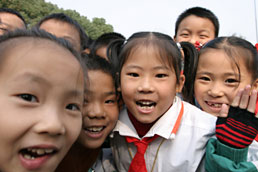

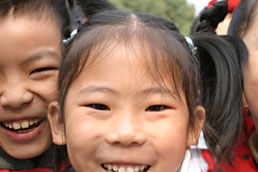
Walking back along the canals I photograph several of the woman gondoliers relaxing while they wait for visitors to take on canal tours. Some are chatting while others are busy knitting. When we get to the three bridges a bright red sedan is being borne by bearers dressed in red across the bridges. The sedans are traditionally used for weddings but also take tourists for rides, accompanied by musicians who lead the way playing shrill reed instruments. I watch a young girl in traditional bride’s costume beaming with enjoyment as she is carried past me and over the bridges. Meanwhile in the canal junction between the bridges the cormorant fisherman is getting ready for another show. From there we go to a guesthouse called Jingyi Tang, set in a courtyard just off a canal. It has four rooms, one of which is beautifully decorated and includes a four-poster bed and even a TV. It costs the equivalent of just £2-£3 to stay per night – incredible value. The house also has broadband internet and the owner’s son is playing a computer game. I am filmed looking at the Beijing diary page on my website. Out in the courtyard one of our escorts from Tongli's Tourist Development Company, Shen Ming, sits and plays the erhu – a Chinese banjo – while singing a traditional Suzhou pingtan ballad. I am filmed listening to him while apparently dozing in a chair, and could quite easily have drifted off to sleep even though the singing is very guttural. After he finishes I noticed a besom – broom – and can’t resist picking it up to do a mock rock guitar riff. I used to be a dab hand at the air guitar in my days running a mobile disco. What I hadn’t counted on is the fact that Mr Ququ is still filming, and catches me doing my Bryan May impression on camera.
We go to see Tongli’s oldest resident, a sprightly 102-year-old lady everyone knows as Hao Po, or Granny Hao. Her ramshackle little house is down a side alley off one of the canals. As we arrive she washes her face and combs her hair because she wants to look presentable for the TV camera and photographs. She is well-known in Tongli and was the town’s wedding arranger for many years. Even today a lot of people ask her advice about wedding traditions and customs.
I am ushered into her living room and sit across from her. She is wearing a blue tunic top and grey trousers. She is quite diminutive and hard of hearing, so that some of my questions have to be shouted to her when they are translated. But she has all her faculties. I ask her how life has changed and whether she prefers it now or before. She doesn’t hear the question first of all and starts counting from one to 10 in English and says: “I can count in English.” When the question is repeated she says she is thankful to the Communist Party. “The Party is very good,” she adds. Not quite the answer I was looking for. She tells me she has one daughter who has three children, and two grandchildren – one 16 and the other four. Her daughter is a professor working at a university in Suzhou. When I ask about her family she gets emotional and excited, saying she only wants a room in Suzhou so that she can live with her daughter and family.
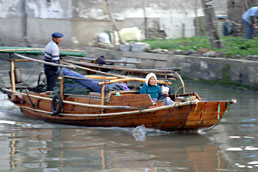
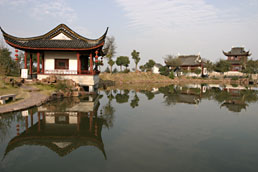
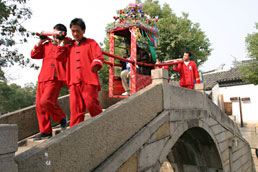
Granny Hao tells me on her 99th birthday her daughter held a large family banquet in a nice restaurant in Wujiang town centre. All her close family members and other relatives were there, making six tables in all. I notice she is sat below a calendar showing a picture of the Arc de Triomphe in Paris with a British Morgan car in front of it. I ask her if she has travelled to Europe and whether she would like to go if she hasn’t. She replies that she hasn’t been to Europe yet but that she would very much like to. She says she is still very healthy and eats a large bowl of rice every mealtime. She gets up and starts pretending to march along to show how healthy she is. I ask her if she has a boyfriend now and what kind of man is she looking for. “Do I stand a chance?” I add cheekily. She gets very serious and says she is not interested in finding a boyfriend now. As long as she can eat and be in good health she is happy. Her only wish is to go to Suzhou to live with her family. I feel well and truly put in my place.
While we are chatting, Granny Hao tells me she goes outside to exercise in the courtyard every morning. So I ask her if she would mind showing me. She uses a walking stick as an aid, but once in the courtyard she puts it down and goes through a quick demonstration of her daily routine. Once again she adopts a serious look as she does her stretches and Tai Chi movements. But for such a venerable age she is remarkably agile and fit. Once she has finished I applaud her, and then she walks with us to the end of the alley to see us off – posing for some final photographs. Her helper takes one arm to guide her back to her home, and as she totters back up the alley I watch in admiration.
On the way back to the tea house I stop to take pictures of the local life. The streets are alive with colour and activity, including a group of old woman sporting headscarves and sat on benches and stools in the main square. No doubt gossiping about some local piece of news. There are some musicians upstairs in the tea house, and we film them playing their traditional instruments. I also photograph one of them relaxing by a window looking out onto the street. The scene is timeless. The man is dressed in a decorated silk robe and flat cap. On the table next to him is an old gramophone player with trumpet loudspeakers. Red paper lanterns hang from the eaves outside the window and a group of people are playing mah-jong at a table in the street below. From a window on the opposite side of the room I look down on a sizeable barge tied up alongside, its decks laden with china pots and bowls of all shapes and sizes. Some children are sat on the quayside next to the barge while washing is strung out to dry next to them. Another craft slowly edges past and under an arched bridge a little further along the canal. Once it has passed the greeny-brown waters return to their mirror-like state. The scene is so restful I could stay up here watching it all day, but I am needed for another film sequence.
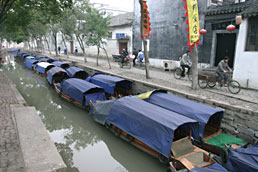
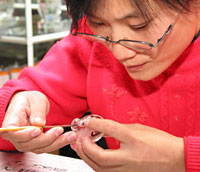
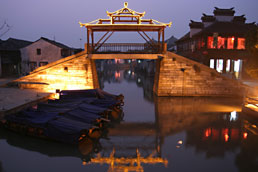
They crew have come across a shop where women are grinding corn, and they want me to help. The grinding wheel is turned by pushing and pulling on a wooden T-frame slung from the rafters on ropes. It looks easy, but is much harder to get the right rhythm when I try it. The corn being ground is for flour to make a cake called pu tang geo, or “cake covered with sugar”. I ask how much I would get if I did it full time and they tell me 1,000 Yuan a month, or about £75. I reply that I would probably eat all my monthly income because the cake is so delicious. After walking past yet more wonderful canal scenes in the old town we head out a short distance to a waterway in the countryside for me to do my last piece to camera by a historic bridge dating back 700-800 years. The bridge is called Si Ben, which translates as remember the basics - in other words, the people. It was paid for privately by a compassionate poet, Ying Ye. At that time China was in turmoil and little respect was being shown to its subjects. He wanted to send a message to the emperor that people were the basis of a country and that he should respect them and treat them benevolently. Sadly, the scene is spoiled by piles of rubbish everywhere. Why is it that some of China’s oldest structures seem to be the least respected? In this instance it seems to go directly against the principle of its benefactor. Before we leave a young boy wearing a pair of blue-green trousers with the fly open and his underpants hitched over the waistband and jumper asks me to photograph him. When I do he promptly gives me a smart salute – except that his palm is facing his head. He seems pleased as punch to have his picture taken, and keeps thanking me.
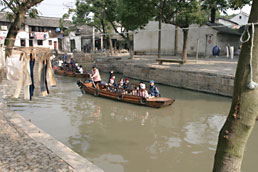
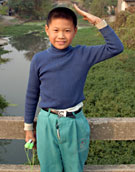
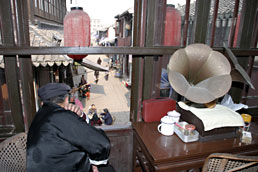
Before leaving the next day I get to demonstrate how bad my singing is at a karaoke bar. Strangely, we don't visit another during the trip. One chance to hear me sing is obviously more than enough. We fly out of Shanghai's new and very impressive airport, which is a far cry from the old world atmosphere of little Tongli. Overlooked in many tourist books, Tongli is a hidden gem. It is not without its problems and the planners face many hurdles in their attempt to tread a fine line between opening up Tongli for more visitors to enjoy and destroying what they want to go there for.
I hope to return to Tongli many times in the future. My wish is that the authorities manage to preserve the spirit and serenity of Tongli, and the friendliness and grace of its people. As with the sentiments of poet Ying Ye, the government of this wonderful little town needs to realise the people are its heart and soul. If it rides roughshod over them in its quest for tourist dollars it will leave an empty, soulless shell.
Next stop: Guangzhou.